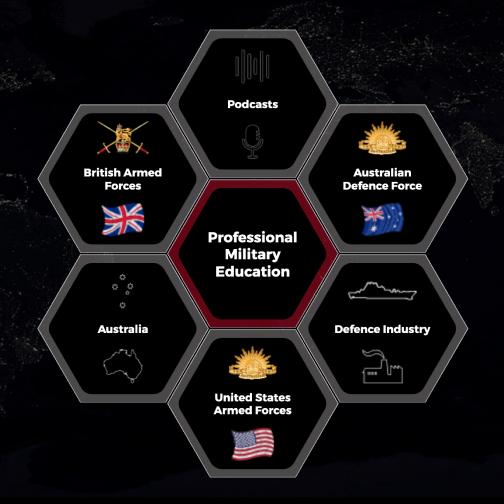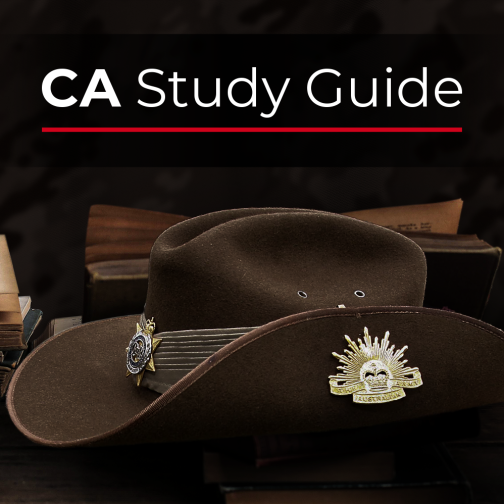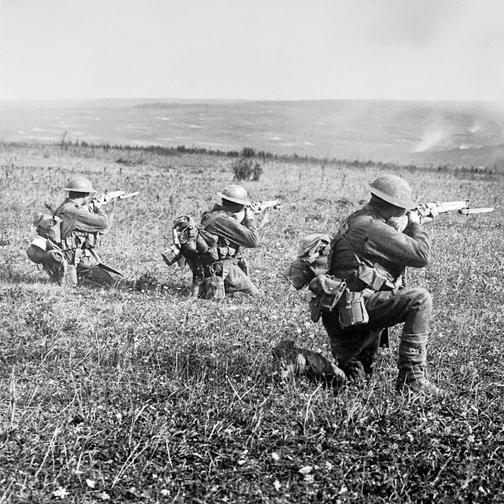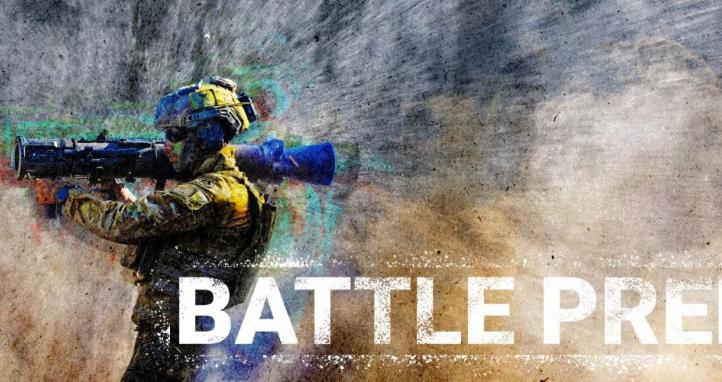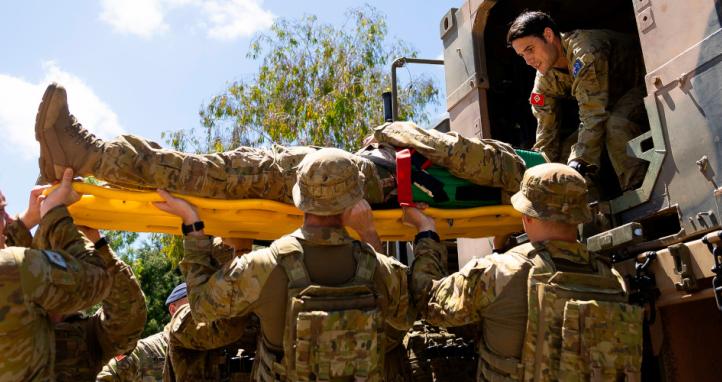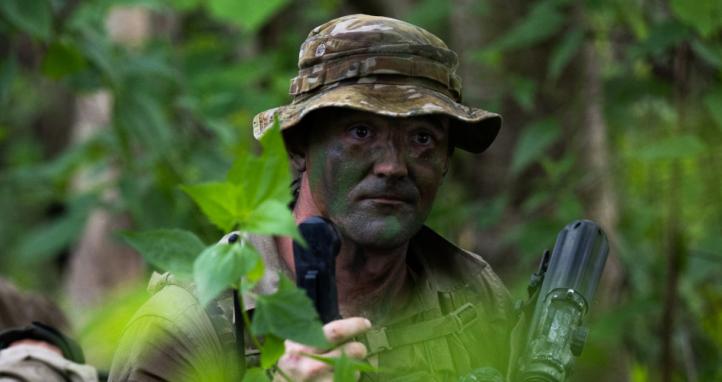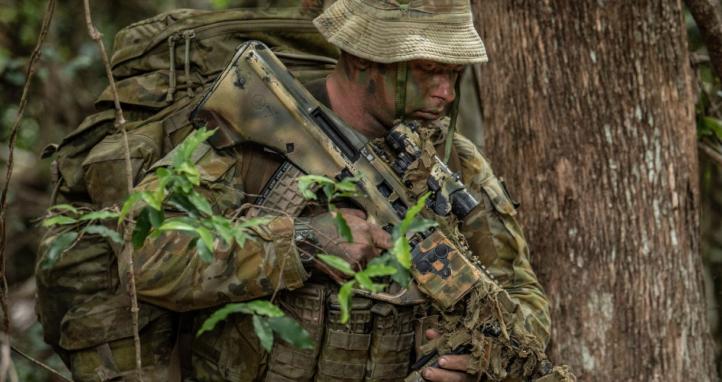'There is nothing new under the sun.'
This oft quoted phrase certainly applies to the study of military history. Although there has been a huge change in the technology of war, and in tactical aspects of its conduct, at its core there are still identifiable trends and strands that weave throughout its rich history. At the heart of warfare is human nature and the human psyche, and how these respond to stimuli. In this way we are less different from our ancient forebears than we might like to admit!
While it is tempting, and in many ways quite natural, to be cautious in applying historical precedents to new situations, there are nevertheless interesting parallels that can be found, and considered by the commander and soldier in their warfighting.
Definition of terms
We will use four main terms in this article which, for commonality of understanding, are defined below:
- Grand Strategy – Encompasses military and political spheres
- Strategy – The overall strategy for the conduct of a conflict
- Operational Strategy – The Operational conduct of units in the field before and after an engagement
- Tactics – The overall movements and techniques involved in an engagement, from unit to individual level
We shall be focusing on the Operational and Tactical elements, although restricting ourselves tactically to broad plans, as the differing ages and technologies make direct comparison of unit and individual tactics invalid.
The final two operations, the battles of Balmoral and Ramadi, will look at a more COIN specific application of Operational Offence – Tactical Defence.
The Campaigns
Thebes vs Sparta, Epaminondas and the establishment of Megalopolis
In 371BC Epaminondas defeated the Spartan Army at Leuctra, one of the most stunning defeats ever suffered by this legendary warrior state. The next year, Epaminondas and his Aetolian Allies marched into the Peloponnese peninsular, the economic and particularly agrarian heartland of Sparta and her Peloponnese allies.
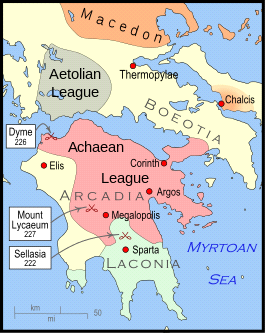
Wikimedia Commons / Map of the Cleomenean War
The Spartans avoided battle with Epaminondas after their reverse at Leuctra the year before. Rather than seek to force them into battle, Epaminondas established the city of Megalopolis, and a Messenian state. Largely composed of freed slaves, this new state became a counter balance to Spartan ascendancy in the Peloponnesian Peninsular. Megalopolis effectively cut off Sparta from its main supply of helots (slaves) and agrarian food source. It also made it difficult for the Spartans to effectively co-ordinate with their allies. While the defeat of Sparta took several more years, we see here an important strategic and grand strategic decision. Epaminondas had severely curtailed the economy of Sparta, and its ability to manoeuvre freely within the Peloponnese peninsular, and thus its ability to wage war, and defend its territory. In this we see a parallel with the Australian’s in Phouc Tuy, and the Americans in Ramadi, the establishment of an armed base of operations in enemy territory that curtails their ability to manoeuvre, and threatens their supply lines of food, weapons and people.
The war between Rome and Carthage: The Italian Campaigns of Hannibal Barca, and African Campaign of Scipio Africanus
In a poetic and perhaps cruel twist of fate, after being in Italy for 15 years, Hannibal was forced to return to Carthage and rush to meet Scipio Africanus, who, taking a leaf from Hannibal’s book, had invaded Carthage. Scipio had subdued, and in some cases converted, Carthage's allies (critically including the Numidian cavalry, who had been a decisive element of the Hannibal's tactical repertoire). This forced Hannibal to return home, after Carthage had already lost an entire mercenary army of 35,000 to Scipio. Hannibal, with an army largely of raw recruits, marched to meet the Romans at Zama, a battlefield selected by Scipio. Standing on a tactical defence, Scipio was able to repel Hannibal’s elephants, before his superior cavalry overcame Hannibal’s. In a reverse of Cannae, Scipio was able to partially envelop Hannibal’s army and rout them. This ended the war, and crushed Carthage as a power in the ancient world.
<>Napoleon Bonaparte’s 1805 Campaign
There were many facets of note in this campaign, and the preparation behind, it well beyond the scope of this article. However, there were broadly two phases. Phase One culminated in the surrender of the Austrian army at Ulm, achieved largely through Operational manoeuvre, where Napoleon was able to cut them off from their supplies, and prevent them from breaking this strategic barrage across their rear.
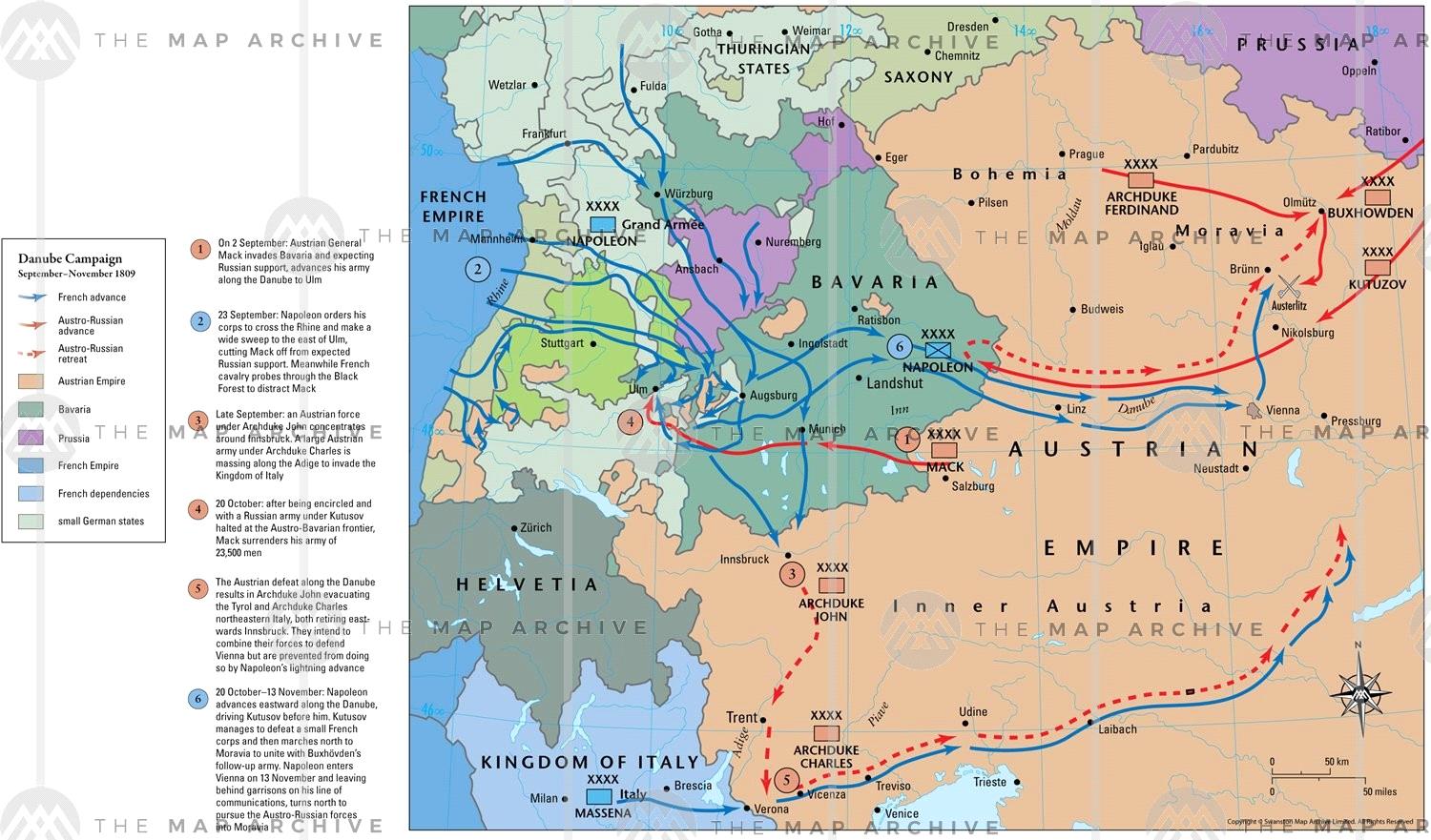
This can be seen in the above map, where the blue arrows represent the French Forces. Marching in dispersed but mutually supporting columns, reminiscent of the Mongol centuries earlier or the armoured campaigns of WWII and the Arab-Israeli wars in the 20th century, the French cut the Austrian Army’s supply lines and forced their surrender. Part of the success here can be attributed to the French army living off the land and thus not being as tied to slow moving supply trains. This freed their ability to manoeuvre and advance more rapidly than their opponents. Phase 2 involved the march to Vienna, and subsequently north to the battlefield of Austerlitz. Napoleon again used a two column approach, allowing him to 'cover and move' or constantly threaten to outflank the Russian Army. His armies remained within mutually supporting distance, and thus the Russians were unable to practice interior lines and crush one army then turn on the other. Napoleon forced them back north East of Vienna. Here Napoleon made deliberate use of his inferior numbers to tempt the allies to advance to battle on a ground of his choosing. Anchoring his 'weak' left wing on a small lake, he allowed the Russians to occupy the heights around Pratzen while hiding the bulk of his troops behind hillocks opposite the Austrian/Russian centre. The Russians attacked Napoleon's left wing, which slowly gave ground. This induced the Russians to commit their reserves, at which point Napoleon struck the weakened centre of their army, cutting off the attacking troops and rolling up both flanks of the Russian and Austrian Army. Similar to Cannae and Trasimene, we see the enemy drawn into attacking an army on the ground of its choosing, with a deliberately exposed or weak element to tempt the enemy to attack. Napoleon used mobile defence to give ground and draw the enemy to commit their reserves in the belief they were winning. Thus over-extended, the enemy was vulnerable to a decisive counter attack at a vulnerable point.
Australian involvement in Phouc Tuy Province, specifically the Battle of Balmoral
There are two facets to this section. Broadly on the grand strategic and strategic level, the mission behind the Australian involvement in Phouc Tuy had several facets.
- Show Australian solidarity with America, partly in hope of strengthening the ANZUS relationship should future threats eventuate in the pacific following the departure of the British.
- Defeat the NVA and VC in Phouc Tuy. 'Winning hearts and minds' became an essential part of this, by cutting off ground level support for the enemy.
- Disrupt enemy supply lines and troop movement within South Vietnam
- Securing the province to allow 'Vietnamisation' of its defence, i.e. to allow ARVN units to take over the defence of the province
Informed by the experiences of Australians and Brits in Malaya, this strategy of nation building and security helped inform the development of COIN strategies and, arguably, also the Seize, Clear, Hold and build strategy later utilised by the Allies in Iraq. Coral / Balmoral Coming down to the Operational level, Operation Toan Thang 1 was a counter-offensive carried out by Australian, ARVN and American forces following the NVA's Tet Offensive in 1968. In this operation, the Australians were operating outside of Phouc Tuy province, as part of a larger allied task force offensive. This offensive against the NVA saw the Australians deploy three battalions, who were deployed around three fire support bases (FSB), Coral, Balmoral, and Coogee. Coral and then Balmoral were assaulted by the NVA.
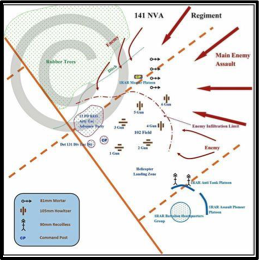
Fire Support Base Coral
FSB Coral was established via helicopter, under the watchful eye of the NVA. The lack of defensive preparation of the FSB and scant defensive forces at the FSB resulted in a hard fought and almost disastrous battle for the Australians, where some guns were over run and Artillery were firing over open sights at the NVA as the NVA launched several battalion size assaults on the Australians.
Thanks to the tenacity of the Australian Soldiers, and the support of air and other fire elements, the NVA were beaten off and suffered heavy casualties. Coral was attacked a further two times, the second time again seeing the forward guns temporarily overrun. This induced the Australians to bring up additional artillery support and tanks.
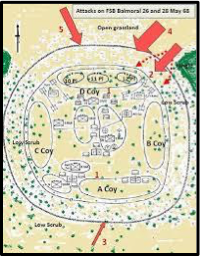
FSB Balmoral
FSB Balmoral, which was subsequently established, was also attacked. However, Balmoral was far better prepared, with pre planned firing lanes, registered artillery, and the carefully hidden reinforcement of Australian Centurion main battle tanks. The NVA again attacked in force (2 battalions), the brunt of the assault falling on D Company 3 RAR. The NVA were met with withering machine gun, artillery, tank and Air support fire, resulting in very high casualties in their assaulting forces. There are several correlations in this example with the previous, but with a difference at the tactical level due to the changes in technology. Operationally and tactically, FSB Coral inadvertently became the subject of an ambush. The drop in via helicopter, designed to take the enemy by surprise, effectively resulted in the Australian FSB being established in the middle of the hornets’ nest. While similar to the previous campaigns, in that it put the Australians in a position encouraging/forcing the enemy to assault them on ground of their choosing, the assault was not expected at the FSB itself. This was reflected by the dispersed nature of the Australian infantry, who were up to 1 km away from the FSB in the AO. Crucially, the NVA were being attacked on a ground of their choosing. Secondly, the slowness of the FSB to establish a strong defensive position opened up the opportunity for an NVA counter-assault. This is where the tactical differences between the ages become apparent. In this instance, the Allied force had complete air superiority, and massive fire-power to draw on. This allowed them to significantly disrupt and destroy enemy formations and reserves, particularly as the Australian Artillery barrages were brought as close as 25m to the Australian lines. Australian casualties vs NVA casualties do not reflect the direness of the situation. Balmoral saw the difference between a prepared position, expecting to be assaulted, and an unprepared one. Balmoral FSB was not penetrated by the enemy. The assault by two NVA battalions fell primarily on one company on the perimeter, who were able to inflict massive casualties on the NVA for minimal losses.
The 2006 Battle of Ramadi – US Seize, Hold, Clear, Build strategy
There are many aspects of the US battle in Ramadi that remain classified. As a civilian, I have even more limited information. However, some basic discernible tenets of the operations are discussed below. Like Phouc Tuy on a small scale, combat outposts gave US troops permanent positions in enemy territory, disrupting the insurgent’s ability to manoeuvre, mutually reinforce, re-supply, and assert power over the local population. These outposts acted also as bait to draw the insurgents out into the open, where the superior American fire-power could decimate them. Like Hannibal's army in Italy, the strategic and grand strategic consequences of American forces in insurgent territory meant that the insurgents were forced to engage the Americans. This process of drawing the enemy onto ground of the Americans' choosing allowed them to 'counter attack' through the use of superior fire-power, albeit far more judiciously applied than in previous conflicts because of the increased sensitivity to the international community to civilian casualties. The Americans combined this with aggressive patrolling, to flush out the enemy, and nation building to secure the support of the population. This is not to say these operations were easy. Like Vietnam, the character of a guerrilla conflict significantly increased the difficulty of positive identification of enemies, and the ROE, designed to minimise civilian casualties, were also exploited by the insurgents as a way of 'fading away' back into the civilian population. The nature of insurgents techniques varied as well. The preponderance of IEDs limited American manoeuvre, and forced a more methodical approach. Operation planning had to take into account whether the armoured support and quick reaction force would be able to reach units on the IED laden streets. The proliferation of RPGS and mortars, while not new, did give the insurgents further ability to strike fast and hard from a distance before disappearing, and gave the some answer to their lack of heavy artillery and armour. Additionally, the confusing and crowded nature of urban combat operations also increased the likelihood of 'blue on blue' incidents. In this case, positive identification became even more critical, and the knowledge of where friendly forces were located.
Distilled thoughts
Having broadly and very briefly surveyed several historical campaigns, we can distil some basic commonalities in the factors contributing to their success.
1. Operationally Offensive movements that force an enemy response, and play upon them on a psychological/political level
In all of these campaigns, operationally the army was on the offensive. However, a key factor is that the offensives were not simply direct advances upon the bulk of the enemy forces (unlike, for example, the Somme). Instead, while perhaps geographically direct these offensives threw the enemy off-guard by striking at objectives that were vital, and forced the enemy force to seek an engagement. Some of these campaigns, such as the 1805 offensive, saw indirect approaches of manoeuvre, cutting the enemy off from their supply lines and forcing them to surrender. In other cases, such as Hannibal and Scipio or the Australians in Phouc Tuy, the arrival of the force into the heartland of enemy territory forced a response from their foe. What made these manoeuvres decisive was not necessarily purely geographic. This is particularly so in the case of Hannibal, Scipio, Vietnam and Iraq. In these cases, the importance of public opinion, and more importantly perhaps the perception of their allies, forced the enemy to engage on unfavourable terms. If an Australian battalion can establish itself in your territory, are you really in control? Are you really the side that people want to be on, if you can’t control your own territory? Hannibal used exactly these elements to maintain himself in Italy for 15 years.
2. Drawing the enemy to an engagement on the ground of your choosing
Through operational manoeuvre the enemy is induced to seek an engagement. However, as they are seeking an engagement the offensive force has the advantage of being able to, to varying degrees, choose where and under what conditions an engagement will take place. Even in the case of Coral and Balmoral, the NVA was induced to attack Australian fortified positions. FSB Coral, under prepared as it was, nevertheless repelled greatly superior numbers. In COIN operations, where the enemy is more likely to know the terrain, and have more ability to 'disappear' into the civilian population, the establishment of fortified positions in their territories still forces them to engage in less favourable conditions.
3. Appearing 'weak' in numbers to induce an enemy assault, which overextends then enemy
Tactically, there appears a common theme: having first established themselves operationally in a position that forces the enemy to engage in a position of their choosing, the successful commanders created 'bait' to draw the enemy into an assault. This might be directly, as in Napoleon at Austerlitz, or more subtly, for example Combat Outposts in Ramadi (which while not completely isolated, were certainly easier targets than larger concentrations of American forces). It is important to note that the 'isolated' detachment was never truly isolated. Instead it was within mutually supportive range of other friendly forces. Sending out isolated detachments without the possibility of them being reinforced, or being supported by other friendly forces, it to invite them to be destroyed piecemeal.
4. Launching a decisive counter attack that strikes at the joint of the overextended enemy. This may be a physical assault, and or through fire-power.
Once the enemy had committed themselves fully to their tactical assault, the successful commanders were able to use their reserves to counter attack. These counter-attacks were not thrown directly at the enemy, but took them instead in the flank, or enveloped them. In the case of Austerlitz, the counter attack, while physically direct, was not directed at the bulk of the enemy forces, but rather at their vulnerable, weakened centre which served as a critical and under-protected joint between the Allied flanks. The splitting of the Russian-Austrian force allowed Napoleon to roll up both flanks separately. The counter-attacks in Vietnam and Ramadi utilised differences in technology. While physical counter attacks still take place, massed fire power can be used to disrupt and destroy the enemy who is now in the open and armed, allowing them to be engaged under the ROE. This can be through aerial support (including UAVs), Tanks, Artillery, AFVs, snipers, machine guns, LAWS etc.
COIN Specific Considerations
COIN operations present their own unique challenges, but broadly have a similar basis as the above ideas. COIN operations may see the operational offensive become more akin to the Theban/Australian strategy of slowly limiting the enemy's ability to supply, recruit and manoeuvre within a given area through the establishment of fortified positions, which form an area of control over the surrounding area.
These outposts must be coupled with aggressive patrolling. Simply having a combat position within an area will not hinder the opponent, as the US fortified village project in Vietnam discovered. Similarly, patrolling without establishing firm bases of operation would seem to not produce the longer term aim of permanently crippling the enemy in that area. Even in Vietnam, VC and NVA were able to operate out of villages and bases within Phuoc Tuy. Above these purely military considerations, there are layers of complexity to do with winning over the population, community and nation building, and defeating the insurgency on a political and moral level. Not simply a military one. This is vital to COIN, as the nature of insurgencies give them a longevity that cannot be overcome simply through military means. This can be clearly see in Iraq and Afghanistan, where initial 'conventional' operations were over within months, but COIN operations continue to today.
Conclusion
The combination of Operational Offence and Tactical Defence have proven to be an effective and perhaps overlooked tool. The initial use of a defensive to draw the enemy out, and convince them to commit their forces against an apparently weaker opponent allows an even more decisive counter assault to take place, as the opposing force, now committed, is unable to parry this counter attack effectively. These defensive actions serve only as a prelude to create the most favourable conditions possible for effective and decisive counter attacks. The modern defence doctrines emphasise offensive action, and rightly pin point this as the way to achieve decisive results. This is merely a variant on that idea. There is a case to be made that operationally offensive manoeuvres can be effectively crowned with tactically defensive engagement/s, providing that those defensive engagements are designed to lure the enemy into vulnerability to decisive counter attacks, including through the use of superior fire-power on now exposed enemy forces.
